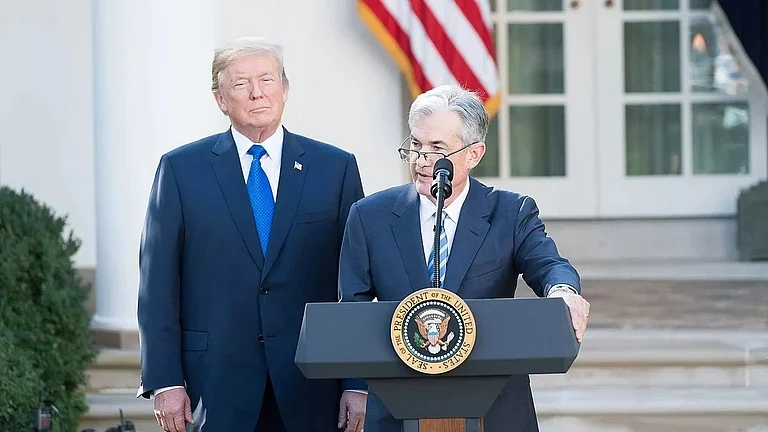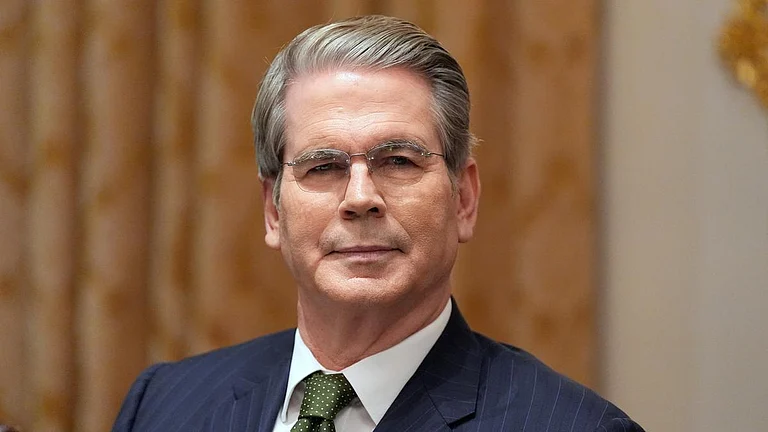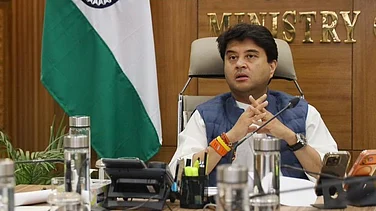After weeks of chaotic murmur over US President Donald Trump's plan to remove Federal Reserve Chairman Jerome Powell, a latest report has claimed that Treasury Secretary Scott Bessent has convinced him against it.
According to The Wall Street Journal, Bessent made a case against firing Powell citing issues like its effects on the economy and stock markets, apart from the likely political and legal challenges such a move could face, even as the US central bank moves toward cutting interest rates. On top of all this, Powell's term at the Federal Reserve is coming to an end in less than 10 months.
The report, citing sources, came after Trump told reporters last week that he had talks with Congress members about removing the central bank chair, during which he claimed that most of them agreed to his view.
Though he later said “We’re not planning on doing it.”
Speaking to reporters in the White House, he further noted, "I don’t rule out anything. But I think it’s highly unlikely, unless he has to leave for fraud.”
How Bessent Lobbied Against Firing Powell?
According to the WSJ report, Treasury Secretary Bessent has advised President Trump that it's unnecessary to fire Powell since the economy is performing well and markets are responding positively to the administration’s policies.
Point to note: US economy contracted by -0.5% between January–March 2025 on an annualised basis, according to the third estimate released by the U.S. Bureau of Economic Analysis. In the fourth quarter of 2024, real GDP had increased 2.4%.
The government agency responsible for the data said that the decrease in real GDP in the first quarter was primarily a reflection of an increase in imports (a sign of panic import ahead of tariffs) and a decrease in government spending (likely due to the impact of cuts by DOGE led by Elon Musk at the time).
Further for the second quarter, according to the Atlanta Fed’s GDPNow model, Q2 growth is estimated at 2.4% annualised as of July 18, 2025.
Meanwhile, inflation remains above the Fed’s 2% target, fuelled by shelter, durable goods, and tariffs. Headline CPI rose 2.7% year-over-year, up from 2.4% in May.
Bessent also reminded Trump that Fed officials have already signalled the possibility of two rate cuts before year-end.
According to reports, at least two central bank officials, Federal Reserve Governor Christopher Waller and San Francisco Federal Reserve President Mary Daly expect two interest rate cuts before the end of this year as the impact of Trump's tariffs remains muted than originally expected.
The third argument by Bessent was firing Powell could trigger legal challenges, create a leadership vacuum, and spook markets, especially with no guaranteed Senate confirmation for a successor. Some GOP senators and Fed watchers have also voiced concern about compromising the central bank’s independence.
Powell’s term ends in May 2026 while another vacancy opens up in January at the Federal Reserve. Bessent’s measured stance contrasts with more aggressive voices in the administration. Trump has described Bessent as “soothing” while talking to reporters on July 17.
Why Trump Wants to Fire Powell?
President Trump's disliking of Federal Reserve Chairman Jerome Powell has been out in public even before his second term started in January. This, even as he was the one who appointed Powell in 2017 replacing Janet Yellen (who became Treasury Secretary under Biden). At the time, he praised Powell for demonstrating “steady leadership, sound judgment, and policy expertise” as a Federal Reserve Governor since 2012.
However, like many of his former allies or colleagues, his relationship became bitter during Biden administration. That happened as under Powell's leadership Federal Reserve started cutting interest rates just before the 2024 presidential election.
While economic experts have regularly said that the US central bank's decision was based on macroeconomic factors including easing sky-high inflation post-Covid. For Trump and his Republican allies the move became a way to help Democratic candidate Kamala Harris in the election (however, it didn't really have the claimed effect as per election outcome). Something Trump reiterated on July 16 from the Oval Office.
He was replying to reporters on the question of whether he had drafted a termination letter for Fed Chair was true, as claimed by a New York Times report earlier. President Trump denied the claim.
In the first six months in the Oval Office, Donald Trump has repeatedly clashed with Federal Reserve Chair Jerome Powell. As the Fed held interest rates steady amid inflation concerns, Trump blamed Powell for economic woes, mocking him with insults like “knucklehead,” “fool,” and “numskull,” and accusing him of playing politics.
Despite Powell’s repeated defence of the Fed’s independence and fiscal discipline, Trump publicly called for his resignation, criticised him for delays in rate cuts, and claimed that he has begun a formal process to find his replacement.
Tariffs and Indecision
Though he has toyed with firing Powell, Trump ultimately left the decision open, while continuing to berate him and the entire Fed board for damaging the economy.
However, interestingly, one of the key reasons for the Federal Reserve to hold back on cutting interest rates is the tariffs announced by the Trump administration. On April 2, the president imposed a slew of massive tariffs on its trading partners. While the so-called retaliatory tariffs were held back till July, the 10% universal tariffs are still in place. Economists have repeatedly said that these levies on foreign countries would ultimately make goods expensive for US consumers.
After the last Federal Open Market Committee (the monetary policy panel) meeting which ended on June 18, Chair Powell and the FOMC noted that tariffs imposed by the Trump administration are likely to pass through to consumer prices, contributing to “meaningful” inflation ahead.
"Everyone that I know is forecasting a meaningful increase in inflation in coming months from tariffs, because someone has to pay for the tariffs... between the manufacturer, the exporter, the importer, the retailer," Powell said. "People will be trying not to be the ones who can pick up the cost. Ultimately, the cost of the tariff has to be paid, and some of it will fall on the end consumer."
The last Federal Reserve rate cut occurred on December 18, 2024, when the FOMC reduced the federal funds rate by 25 basis points to 4.25%–4.50%, marking the third consecutive cut that year (September, November, December). Since that cut, the Fed has held rates steady through mid‑2025, with no further reductions. They have maintained the 4.25%–4.50% range at four successive meetings. Of the 19 FOMC members, only a few supported an immediate cut in the last meeting, while most preferred waiting until inflation trends clarified.
Can US President Fire Fed Chair?
Powell has been asked this question multiple times including his first monetary policy press conference after Trump came back to power. He clearly said that “this is not permitted under the law.”
Although the Federal Reserve is part of the executive branch, and the Constitution vests executive power in the president, his authority to remove agency heads is not clearly defined. Any formal attempt by the White House to dismiss the Federal Reserve Chair would be unprecedented. Traditionally, US presidents have respected the central bank's independence, even when policy disagreements arose. And the power to remove members of any federal agencies was usually followed by a 1935 Supreme Court judgement called Humphrey’s Executor case.
The 1935 Supreme Court ruling in Humphrey’s Executor v. United States limited presidential removal power by upholding that Congress can impose "for cause" removal protections for independent agencies. These causes include—Inefficiency, Neglect of duty, Malfeasance in office.
In May, the U.S. Supreme Court also indicated that the president cannot fire the Fed chair. It made an observation during hearing in firings at other federal agencies (the National Labor Relations Board (NLRB) and the Merit Systems Protection Board (MSPB)).
“The Federal Reserve is a uniquely structured, quasi-private entity that follows in the distinct historical tradition of the First and Second Banks of the United States,” the court noted. Although the case is still ongoing, some experts claim that it would eventually lead to court overturning the precedent. Although it still hasn't happened.
But reports have made it clear that Jerome Powell will seek legal remedy if the president ends up firing him.
Another Way to Remove Powell
As the debate on the president's power to remove Fed Chair continues, Trump has likely found another way to remove him, this time through the use of allegations of "fraud." This is something he has started talking about publicly in recent weeks.
The issue relates to the renovation and overhaul of two historic buildings (the Eccles Building and FRB‑East) in Washington, D.C. The renovation was approved in 2017 and the work began in 2021. However, reports say the renovation originally estimated at $1.9 billion has now ballooned to about $2.5 billion, roughly 30–34% overrun.
Fed officials, meanwhile, say the cost overrun has been driven by inflation, environmental remediation (asbestos, soil contamination), and design revisions including underground garages and atria.
Members of the Trump administration, including Office of Management and Budget (OMB) Director Russell Vought and National Economic Council’s Kevin Hassett, have accused Chair Powell of fiscal mismanagement, criticising alleged features like rooftop gardens, VIP dining rooms, marble finishes, and private elevators.
In June, Powell testified under oath during a Senate hearing, “There’s no VIP dining room, there’s no new marble… no water features… no beehives… no roof garden terraces.”
However, facing mounting criticism, Powell requested that the Fed’s Inspector General conduct an independent review of cost overruns and compliance with planning laws.
President Trump recently appointed three advisers, including one directly linked to Russell Vought, to a local planning commission that had approved the Federal Reserve’s renovation plans. They also requested a site visit to inspect the ongoing renovation. The WSJ report noted deputy chief of staff James Blair as saying, the Fed offered a Friday evening tour, but the time was inconvenient for the group, who have asked to reschedule the visit for next week.
Trump on July 16 said it's “possible there’s fraud involved with the $2.5, $2.7 billion renovation.” Earlier, Vought had also said Trump believes “it’s possible there’s fraud involved with the $2.5 billion” renovation project.
Meanwhile, Trump has already started scouting for a new Federal Reserve Chair. He said he would prefer someone who can keep interest rates low. He also noted his National Economic Adviser Kevin Hassett is in the race including others but he hasn't decided on a name.











.jpg?auto=format%2Ccompress&fit=max&format=webp&w=768&dpr=1.0)





















